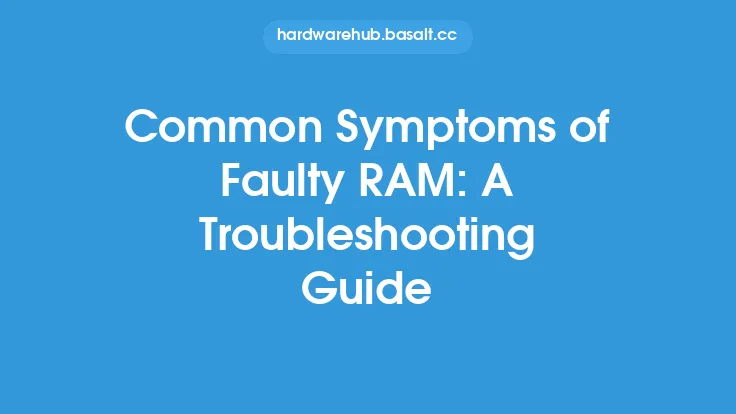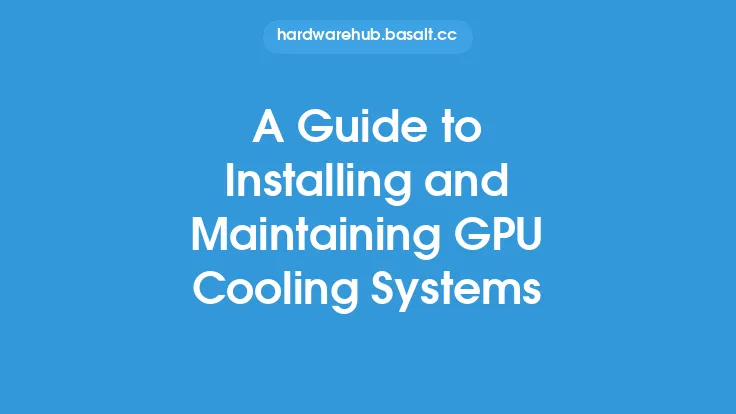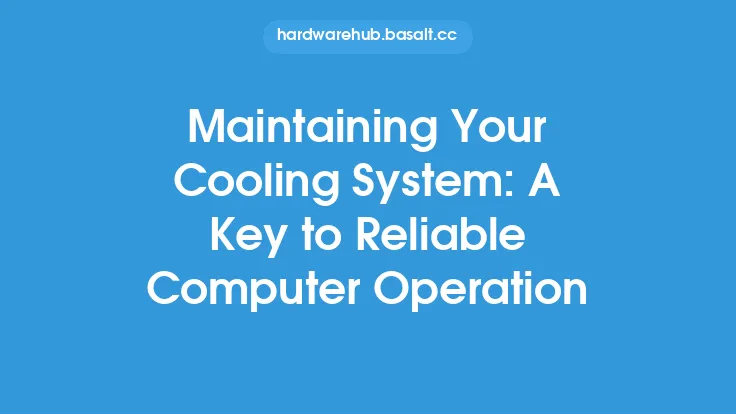When it comes to maintaining the health and performance of your cooling system, troubleshooting common issues is a crucial aspect of ensuring optimal functionality. A well-maintained cooling system is essential for preventing overheating, reducing the risk of damage to components, and promoting overall system reliability. In this article, we will delve into the world of cooling system troubleshooting, exploring the most common issues that can arise and providing you with the knowledge and skills necessary to identify and resolve them.
Introduction to Cooling System Components
Before we dive into the troubleshooting process, it's essential to have a solid understanding of the various components that make up your cooling system. These components include the radiator, water pump, thermostat, hoses, and cooling fans. Each of these components plays a critical role in the cooling process, and understanding their functions and interactions is vital for effective troubleshooting. The radiator, for example, is responsible for dissipating heat from the coolant, while the water pump circulates the coolant throughout the system. The thermostat, on the other hand, regulates the temperature of the coolant, ensuring that it remains within a safe operating range.
Common Cooling System Issues
There are several common issues that can arise in a cooling system, each with its own unique set of symptoms and causes. One of the most common issues is a leak in the system, which can be caused by a variety of factors, including worn or damaged hoses, loose connections, or corrosion. Another common issue is a faulty thermostat, which can prevent the system from regulating temperature effectively. Other issues can include a malfunctioning water pump, a clogged radiator, or a faulty cooling fan. In some cases, these issues can be caused by a combination of factors, making diagnosis and troubleshooting more complex.
Troubleshooting Cooling System Leaks
Troubleshooting a leak in the cooling system requires a systematic approach, starting with a visual inspection of the system's components and connections. Look for signs of leakage, such as puddles of coolant or water spots, and check the hoses and connections for any signs of damage or wear. If the leak is not immediately apparent, you may need to use specialized tools, such as a pressure test kit, to help identify the source of the leak. Once the leak has been located, you can begin to repair or replace the damaged component, taking care to ensure that all connections are secure and tightened properly.
Diagnosing Thermostat Issues
A faulty thermostat can be a challenging issue to diagnose, as the symptoms can be similar to those of other cooling system problems. However, there are several key indicators that can suggest a thermostat issue, including a temperature gauge that reads consistently high or low, or a cooling system that fails to regulate temperature effectively. To diagnose a thermostat issue, you can use a thermometer to check the temperature of the coolant, comparing it to the specified operating range. You can also use a multimeter to test the thermostat's electrical circuit, checking for any signs of malfunction or damage.
Repairing or Replacing the Water Pump
The water pump is a critical component of the cooling system, responsible for circulating the coolant throughout the system. If the water pump fails or becomes damaged, it can cause a range of problems, including overheating, corrosion, and damage to other components. To repair or replace the water pump, you will need to disconnect the hoses and electrical connections, taking care to ensure that all components are properly labeled and secured. You can then remove the old water pump and install a new one, making sure to follow the manufacturer's instructions and specifications.
Cleaning and Maintaining the Radiator
The radiator is a critical component of the cooling system, responsible for dissipating heat from the coolant. Over time, the radiator can become clogged with debris, corrosion, and other contaminants, reducing its effectiveness and increasing the risk of overheating. To clean and maintain the radiator, you can use a combination of specialized tools and techniques, including a garden hose, a soft-bristled brush, and a radiator cleaning solution. You can also use a pressure test kit to check the radiator for any signs of leaks or damage, taking care to ensure that all connections are secure and tightened properly.
Troubleshooting Cooling Fan Issues
The cooling fan is a critical component of the cooling system, responsible for drawing air through the radiator and dissipating heat. If the cooling fan fails or becomes damaged, it can cause a range of problems, including overheating, corrosion, and damage to other components. To troubleshoot a cooling fan issue, you can use a multimeter to test the fan's electrical circuit, checking for any signs of malfunction or damage. You can also use a thermometer to check the temperature of the coolant, comparing it to the specified operating range. In some cases, you may need to replace the cooling fan or repair its electrical circuit, taking care to follow the manufacturer's instructions and specifications.
Preventing Cooling System Issues
While troubleshooting and repairing cooling system issues is essential, preventing them from occurring in the first place is equally important. There are several steps you can take to prevent cooling system issues, including regular maintenance, such as checking the coolant level and condition, inspecting the hoses and connections, and cleaning the radiator. You can also use specialized tools and techniques, such as a pressure test kit, to help identify and diagnose potential issues before they become major problems. By taking a proactive approach to cooling system maintenance, you can help ensure optimal performance, reduce the risk of overheating and damage, and promote overall system reliability.
Conclusion
Troubleshooting common cooling system issues requires a combination of technical knowledge, specialized tools, and a systematic approach. By understanding the components and functions of the cooling system, identifying common issues and their causes, and using the right techniques and tools, you can effectively diagnose and repair a range of problems, from leaks and thermostat issues to water pump and cooling fan failures. Whether you're a seasoned technician or a DIY enthusiast, this guide has provided you with the knowledge and skills necessary to troubleshoot and maintain your cooling system, ensuring optimal performance, reliability, and longevity.





